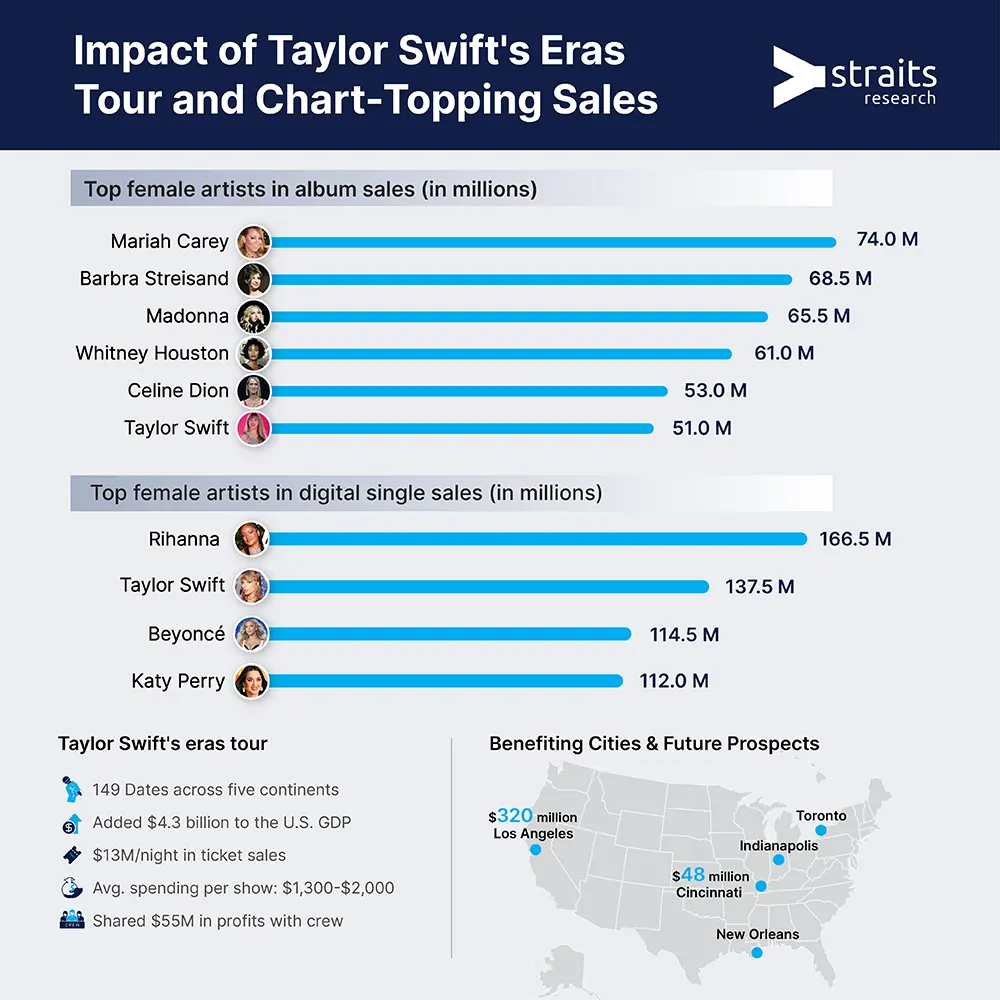The Economic Impact of Taylor Swift’s Eras’ Tour

With her 'Eras' tour, 33-year-old American pop sensation Taylor Swift is not only breaking records in the music industry but also accelerating economic growth and changing the dynamics of labor compensation. Swift's tour, which is sometimes referred to as "Swiftonomics" or "Taylornomics," is an economic phenomenon that is totally altering the rules of entertainment economics in addition to being a musical act.
Swift's Funflation Effect
"Funflation" is a term used to describe the rise in demand for live entertainment following the COVID-19 pandemic, driven by increased savings and unmet demand. Funflation, or the change in consumer behavior that may eventually help the entertainment industry, is best illustrated by the 'Eras' tour. More than just a set of shows, Taylor Swift's "Eras" tour is a massive commercial success. This tour is a tribute to her albums and it began in March 2023 and is scheduled to end in December 2024 with 149 dates spread over five continents.
Swift's tour caused an unprecedented economic surge. In addition to breaking records for income, attendance, and ticket costs, the tour has also raised the bar for charity. Taylor Swift shocked everyone in July when she revealed that she was giving her Eras crew a whopping $55 million in bonuses. This bonus money went to everyone from truck drivers to backup dancers to sound technicians. Swift's influence has brought about an economic rebound in a number of cities. According to Bloomberg Economics, the country's Gross Domestic Product has increased by an estimated $4.3 billion as a result of her 53 concerts in the United States this year.
Her concerts draw tens of thousands of people for days at a time. As a result, there is a surge in demand for labor in industries like restaurants, retail stores, and security firms. Many businesses turn to hiring temporary workers in order to meet this demand. For instance, within a half-mile radius of Swift's Boston-area shows, Instawork, a platform that enables businesses to hire hourly workers, reported an astounding 1,000% increase in demand for hourly workers.
Demographic influence and commercial success
A demographic analysis of concertgoers shows that 58% of them are between the ages of 35 and 64, 37% are between the ages of 18 and 34, and 5% are under the age of 18. Moreover, Swift is fifth among all female artists whose music is listened to in the US in terms of album sales, according to data from the Recording Industry Association of America (RIAA). Renowned artists like Mariah Carey and Madonna are in front of her; with 74.0 million album sales, Mariah Carey tops the group. Barbra Streisand is next in line with 68.5 million album sales, followed by Madonna with 65.5 million, Whitney Houston with 61.0 million, Celine Dion with 53.0 million, and Taylor Swift with 51.0 million album sales.
Swift comes in second when it comes to digital single sales, which typically go to more recent artists. With 166.5 million digital single sales, Rihanna leads the pack. Taylor Swift (137.5), Beyonce (114.5), and Katy Perry (112.0 million) come in after her. Interestingly, with an average attendance of 72,000 per night during the U.S. leg of the tour, this tour has maintained an amazing pace, earning an estimated $13 million in ticket sales per night. Taylor Swift is now a billionaire due to the tour, which has generated over $700 million in ticket sales to date.
The hotel industry is also affected economically, in addition to concert venues. Hotels in the U.S. have benefited greatly from Swift's tour, which has generated an extra $208 million in room revenue. In the cities or states where Swift performed, revenue per room increased by 7% over the same periods last year, with revenue generated per room exceeding the national benchmark by an average of over 4%. Nashville, Indianapolis, Minneapolis, Cincinnati, Seattle, Los Angeles, New Orleans, and Toronto are a few notable examples.
The two sold-out Swift concerts at U.S. Bank Stadium in Minneapolis brought in an estimated 120,000 fans, creating a new record for the total number of hotel rooms occupied. Minneapolis generated almost $6 million in total revenue from visitors with an occupancy rate of 96.3%. Every time Taylor Swift performs, fans spend over $1,000 on merchandise, hotel booking, food, and other expenses. The tour is expected to have a staggering $320 million economic impact in Los Angeles.
During Swift's two-day visit in late June, Cincinnati reported a boost in net new local spending of $92 million and $48 million in concert sales. Furthermore, fans go all out for Taylor Swift concerts. They typically spend $250-$300 on tickets, $100-$150 on merchandising, and $50-$100 on food and drinks at the event. The cost of travel to the show can vary from $500 to $1,000. The average concertgoer spends between $1,300 and $2,000 overall for each show.
Swift's extraordinary influence on local economies, accommodation, and tourism is largely attributed to her fans'. The 'funflation' phenomenon that she represents has the potential to influence live entertainment going forward, with long-term advantages for the sector.




